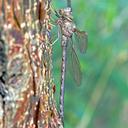Description: Both sexes are very similar. When they are adults the eyes are greenish and when they are not mature the eyes are brown. Entirely ligth brown from face to abdomen tip. Small black spots on thorax and faint indications of patterning on abdomen. Mature individual at brightest with fron of thorax greenish, ligth green sclerites between wings and fine light green abdominal rings and lines (Paulson, 2009).
Size: Total length: 75-80mm; abdomen: 56-60mm; hindwing: 47-56 mm.
Similar Species (US and northen México): Bar-sided (G. mexicana) is similar but with blue on abdominal segments 1-3 and have marks on the sides of the thorax. The epiproct is also longer in the male Twilight Darner and the cerci are longer in females. G. helenga have yellow cerci.
Habitat: Rivers and streams in woodland in lowlands.
Natural History: It is common to observe them during the dusk feeding on insects sometimes in large numbers. Usually fly to low ground. Female searches out shallow pools in or at edge of woodland and oviposits in rotten wood or mud. May lay eggs in depressions before they fill with rain, and late-emerging adults may live for months to breed in next rainy season.
Distribution: There is a record in Oklahoma, Florida, USA; Mexico to Brazil and througout West Indies.
Source:
Paulson, D. R. 2009. Dragonflies and Damselflies of the West. Princeton University Press.535 pp.
Paulson D. R. and E. Gonzalez-Soriano. 1994. Mexican Odonata. An online resource available at: https://www.pugetsound.edu/academics/academic-resources/slater-museum/biodiversity-resources/dragonflies/mexican-odonata/
Edited by Juan Cruzado (12/09/2016).
